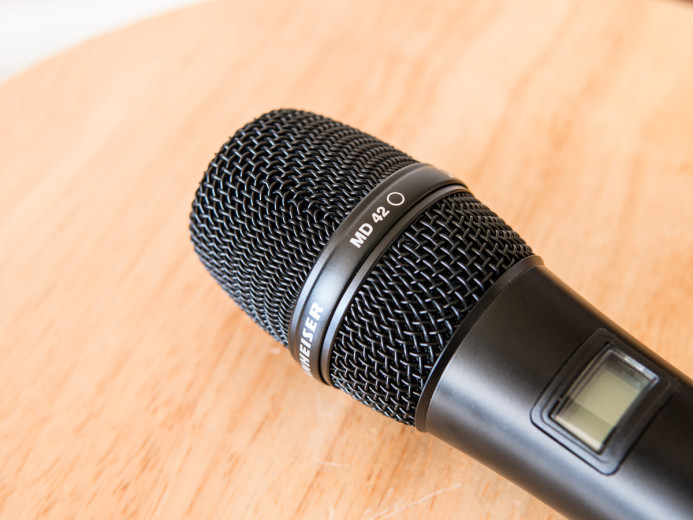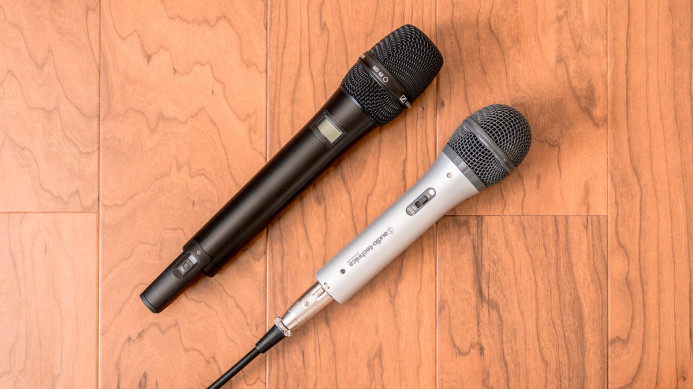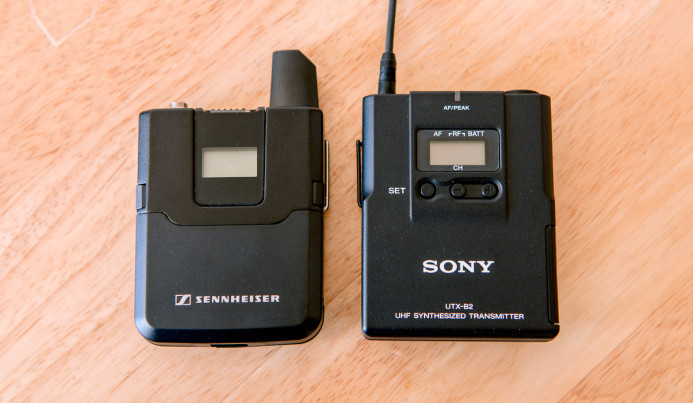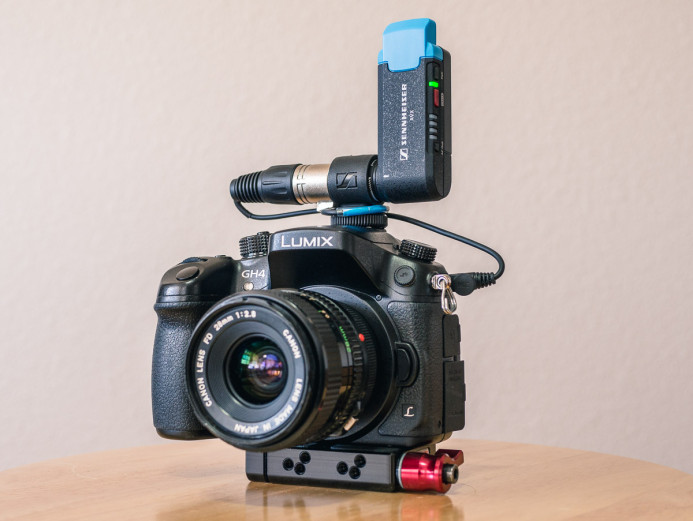Review: Sennheiser AVX Wireless Audio System
Sennheiser’s AVX wireless audio system may be compact and easy to use, but does it deliver the audio performance to match?
Sennheiser sent over the AVX system, and we’ve been evaluating its performance before we take it out into the field. The AVX’s compact design and 5-second setup is sweet, but at the end of the day, its performance is what really matters, and that’s the focus of this review.
Catch up: Sennheiser AVX Wireless Audio System: Overview & Setup — Read the first part of this review to get up to speed on the AVX’s features and functionality.
Just the Stats Ma’am
- Mic type: Lavalier / Handheld
- Connectivity: XLR (3-pin) / 3.5mm TRS (using included adapter)
- Sampling Rate: 24-bit / 48kHz
- Dynamic Range: Over 120 dB(A)
- Signal-to-noise Ratio: Over 90 dB(A)
- Level Control: Automatic
- Output Level: 0, -10, -20 or -30 dBu
Power
- Battery type: Rechargeable Li-ion battery packs (proprietary)
- Runtime: 10+ hours (transmitter) / 4+ hours (receiver)
Wireless
- RF Band: 1.9GHz (license-free)
- Transmission: Digital (256-bit encryption)
- Range: 30+ meters (100+ feet)
- Channel Selection: Automatic
Other
- Weight (including batteries)
- Receiver: 84g
- Bodypack Transmitter & Lavalier Mic: 152g
- Handheld Mic: 314g
- Warranty: 2 Years
- Price: $899-1299 (depending on configuration)
Auto-Leveling: The Return of AGC?
One of the AVX system’s central features is its ability to automatically adjust to give you the best audio levels in different situations, from boosting quiet audio to lowering loud audio to prevent clipping.
This sounds a lot like the dreaded Automatic Gain Control (AGC) that we’ve been fighting against ever since the “feature” was introduced in consumer/prosumer cameras. AGC is bad because while it does an adequate job of keeping audio from clipping, it’s usually not smart enough to discern a soft-spoken person from a silent room. As a result, AGC can boost audio levels until the white noise of a quiet room is deafening.
Surely Sennheiser wouldn’t add something so heinous as AGC to the AVX system, right?
Technically, the AVX does have Automatic Gain Control, but it’s not the same AGC of old. According to Sennheiser, the AVX’s wide dynamic range– over 120 dB(A)– allows the audio to be shifted to keep levels normalized, rather than being raised and lowered haphazardly. This is useful when the handheld mic is passed between multiple people who may speak at different volumes.
The AVX’s auto-leveling also does a good job of protecting against audio clipping. It is still possible to cause the audio to clip with a loud burst of sound out of nowhere, but for the most part, levels are kept under control quite well.
You could call the AVX’s auto-leveling functionality “intelligent AGC”, because it boosts quiet audio, but it does not appear to increase audio levels noticeably during moments of silence like traditional AGC threatens to do whenever your talent stops talking.
So far, the AVX’s AGC is smart enough for us to worry about it in actual production, but we’ll be listening closely for any pitfalls that may arise in certain situations as a result of this automated functionality.
Audio Quality
No matter how convenient it may be, a wireless system that lacks audio quality is unusable.
Thankfully, the AVX system has a wide dynamic range of over 120 dB(A), a solid signal-to-noise ratio of over 90 dB, and it captures 24-bit audio at 48kHz. That’s quite good, and the results reflect this with very usable audio quality.
Long-term testing in actual production will determine whether the AVX is up to the task, but here are some tests comparing the AVX system to other wired and wireless options:
Handheld Mic: MD-42
The AVX’s wireless handheld mic features and interchangeable mic module. The one we are testing is Sennheiser’s MD-42 module.
The MD-42 is an omni-directional mic, which means it picks up sound from all around the mic, meaning it’s not as directional as a mic with a cardioid pickup. As such, it may not offer the best isolation for voice over or narration work, but it should work well for news-gathering and interviews where you don’t always have the luxury of optimal mic placement.
Here’s a comparison between the AVX’s MD-42 wireless handheld mic and Audio-Technica’s hardwired ATR2100 (a cardioid mic):
Both mics were set up next to each other and positioned in front of the speaker. Sennheiser’s MD-42 mic has a bright sound, while the AT2100 captures much more of the low end range. That said, both mics would sound quite nice with a bit of work with the EQ.
In fact, I was surprised by how well the MD-42 performed in this test. Despite being an omni-directional mic, the MD-42 performed well in a quiet room. A cardioid mic provides better isolation, but I wouldn’t hesitate to use the MD-42 for narration in a pinch. Furthermore, its balanced and natural sound makes the MD-42 a good option for documentary and news-gathering work.
Lavalier Mic: ME2
The AVX system comes various configurations that include different lavalier mics. We are testing the ME2 mic capsule, but you can also get the more sensitive MKE2 mic capsule for about $150 more.
Note: The AVX bodypack transmitter uses a threaded 3.5mm plug, allowing you to use other mics with the system as well.
Sennheiser’s ME2 performs well compared to other wireless mics. Here’s a comparison between the ME2 mic and Sony’s lav mic included in the UWP-V1 wireless system:
Both mics were clipped on the speaker’s shirt, roughly 8in below the speaker’s mouth and connected to their respective wireless transmitters. No windscreens were used on the mics for the test.
Latency
Like other digital wireless audio systems, there is some latency when recording with the AVX system. Sennheiser state that the AVX system has 19ms of latency, and this was confirmed in our tests.
Compared to wired or analog wireless audio, the AVX’s 19ms delay sounds like a bit reverb on the live audio, so it may take some getting used to when you’re monitoring the audio. It was a bit strange at first, but I quickly got used to the latency after using the system for a short time.
While 19ms is more of a delay than other wireless systems such as Sony’s UWP-D11 (0.35ms) and Rode’s Rodelink (4ms), it shouldn’t be too much of an issue when shooting video as the delay amounts to less than a frame in many situations. You can also always shift the audio on the timeline for perfect sync if it’s noticeable to you.
In any case, we’ll be keeping an eye on the AVX’s latency and will report back after some long-term testing in the field.
Wireless Performance
Of course, the primary reason to use a wireless audio system despite the additional power requirements, latency, and limited mic options is the freedom! A wireless mic is untethered from the camera or mixer, allowing for a greater range of independent movement of the camera and mic.
However, two be effective, a wireless system needs to deliver in two key areas– range and connection quality.
Range
Sennheiser say that the AVX has a range of at least 30 meters in normal video production conditions where there may be obstructions between the transmitter and the receiver. In direct line-of-sight, the range should be even better according to Sennheiser.
30 meters through walls is more than enough for our needs, and while we haven’t tested how many walls the AVX system can transmit through, nor how much each wall affects its range, but audio was clean and clear through several walls (sheetrock with metal and wooden studs) as we tested the system.
We’ll have more details on usable range in environments with different obstructions (concrete, metal, etc.) as well as the AVX’s maximum range in direct line-of-sight after we take the AVX system out into the field for a while.
Connection Quality
The AVX features automatic channel switching to continually provide a clear audio signal. Sennheiser say that the AVX can detect interference and switch to a clear channel before you ever hear anything.
Lofty claims, but so far, we haven’t experienced anything that would disprove them. All recordings with the AVX system have been static free.
It’s good that the AVX’s automatic channel hopping works well, because without any manual control over channels, it’s the only option you have. I am interested to see how well the AVX fares out in the field where we’ll be shooting in a wider range of environments that may be subject to more RF activity.
AVX Heading into the Field
I was initially wary of the AVX’s lack of manual controls, but over time, I’ve grown fond of the very quick setup and compact size of this system.
That said, if quality was compromised, it would be a no-go, but the AVX has delivered solid performance during our tests, so it is now heading out into the field on actual productions. I’m looking forward to putting the AVX system to work to see how it holds up under real-world conditions.
I’ll report back once we’ve put the AVX system through the ringer. Sign up below to get those updates automatically and let me know if there’s anything specific you want me to test on the AVX system.
Related
Sennheiser AVX Configurations
- Receiver/ME2 Lavalier Mic ($899)
- Receiver/Handheld Mic ($899)
- Receiver/MKE2 Lavalier Mic ($1049)
- Receiver/ME2 Lavalier Mic/Handheld Mic ($1299)
Audio Resources for Video Production
- Review: Zoom H5: Run & Gun Audio Recorder
- Review: Sennheiser AVX Wireless Audio System
- Review: Beachtek MCC-2 Audio Adapter
- The Definitive Guide to Audio Input Options




